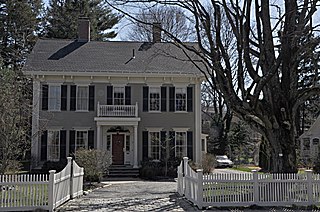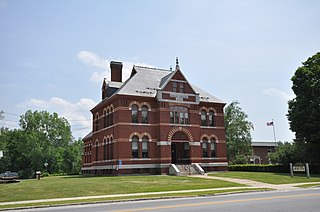
St. Mary's Catholic Church is a parish church of the Catholic Church in Winchester, Massachusetts, within the Archdiocese of Boston. It is noted for its historic church at 159 Washington Street, which was listed on the National Register of Historic Places in 1989, reflecting its important role among the local Irish Catholic community. The parish also operates St. Mary's Early Learning Center, a preschool and kindergarten, the successor to St. Mary’s School, a parochial school which operated until 2020.

The Leavitt–Hovey House is an historic house located at 402 Main Street in Greenfield, Massachusetts. Built in 1797, it is a prominent work of local architect Asher Benjamin, and a good local example of Federal period architecture. From 1909 to June 17, 2023, it served as the home of the Greenfield Public Library.

The Main Street Historic District encompasses the civic core of Greenfield, Massachusetts, the county seat of Franklin County, Massachusetts. The district includes several blocks of Main Street extending roughly from Chapman Street in the west to Franklin Street in the east, as well as a number of properties facing the common along Bank Row, south of Main Street, and is architecture reflective of the city's 19th-century growth as a major crossroads and county seat. The district includes the town hall, county courthouse, several 19th century bank buildings, and three properties previously listed on the National Register of Historic Places: the Garden Theater Block, the Leavitt-Hovey House, and the 1915 Post Office building. The district was listed on the National Register of Historic Places in 1988.

The Battell House is a historic house located at 293 Haverhill Street in Reading, Massachusetts. Built about 1806, it is a fine local example of transitional Georgian-Federal architecture. It is notable as the home of Charles Battell, a veteran of the American Civil War. It was listed on the National Register of Historic Places in 1984.

Winn Farm is a historic farmhouse at 57 Summer Street in Arlington, Massachusetts, USA. The 2+1⁄2-story wood-frame house is estimated to have been built c. 1820, and is the only surviving farmhouse in northwestern Arlington from that period. It is a typical Federal style house, five bays wide, with a center entrance, standing in a part of the town that was not developed more fully until the 20th century. Albert Winn, its likely builder, was active in local civic affairs, serving in town offices and as a state representative.

The Albert Ayer House is a historic house in Winchester, Massachusetts. Built around the year 1865, it is a conservative but detailed example of early Italianate architecture. It was built for a locally prominent civic leader. The house was listed on the National Register of Historic Places in 1989.

The Alfred Vinton House is a historic house at 417 Main Street in Winchester, Massachusetts. It is a two-story wood-frame structure, three bays wide, with a side gable roof that has bracketed eaves. The front is symmetrically arranged, with a center entrance flanked by sidelight windows, and set under an elaborately decorated front porch. A round-arch window stands above the entrance. Gardner Symmes, a local builder, built the Italianate house c. 1854, and may have lived in it before Alfred Vinton, a local lawyer who married into the Symmes family, bought it in 1862. It remained in the Vinton family into the 1920s.

The Carr-Jeeves House is a historic house in Winchester, Massachusetts. Built in 1869, it is fine local example of Second Empire architecture. It was listed on the National Register of Historic Places in 1989.

The Deacon John Symmes House is a historic house in Winchester, Massachusetts. Built about 1807, it is a fine local example of Federal period architecture, and is also significant for its association with the Symmes family, who were among Winchester's earliest settlers. The house was listed on the National Register of Historic Places in 1989.

The George Brine House is a historic house in Winchester, Massachusetts. Built about 1865, it is a well-preserved example of Second Empire architecture. It was listed on the National Register of Historic Places in 1989.

The Horace Hatch House is a historic house in Winchester, Massachusetts. Originally located on Lloyd Street, this c. 1835 Greek Revival cottage was moved to its present location on Grove Street c. 1843. It is a locally rare example of a side gable Greek Revival cottage whose roof overhangs its full-width front porch. The house is similar to the nearby Hovey-Winn House, and may have been built by the same housewright, John Coats.

The Hutchinson-Blood House is a historic house at 394-396 Main Street in Winchester, Massachusetts, United States. The 2.5-story wood-frame house was built around 1840 by John Coats, a local housewright. The Greek Revival house was built by Coats for his in-laws, Samuel and Lucetta Hutchinson. It is basically Federal in styling, although it has a Greek Revival entry surround. The main house has had a two-story addition added to the rear, as well as a side porch.

The James H. Mann House is a historic house at 23 Hancock Street in Winchester, Massachusetts. The 2+1⁄2-story wood-frame house was built by James H. Mann for his own use. Mann was a prominent local builder who also built the Carr-Jeeves House, another picturesque house with a mixture of architectural elements. This house is predominantly Gothic Revival in character, with its main body topped by a double roof roughly looking like a monitor. There is a three-story tower topped by a jerkin-headed roof, whose gable lines are decorated by Stick-style vergeboard.

The Marshall Symmes House is a historic house in Winchester, Massachusetts. Built c. 1817, it is a rare local example of Federal period brick-end house, and is further notable for its association with the Symmes family, who were among Winchester's earliest settlers. The house was listed on the National Register of Historic Places in 1989.

The Marshall Symmes Tenant House is a historic house in Winchester, Massachusetts, USA. Built in the 1870s as a rental property on land owned by Marshall Symmes (1789-1889), this Italianate house is notable for its association with the Symmes family, who were among Winchester's first settlers. The house was listed on the National Register of Historic Places in 1989.

The Thomas Ayer House is a historic house at 8 Grove Street in Winchester, Massachusetts. Built about 1864, it is a conservative but detailed example of early Italianate architecture. It was built for a prominent local businessman and politician. The house was listed on the National Register of Historic Places in 1989.

The Winchester Center Historic District encompasses the commercial and civic heart of Winchester, Massachusetts. It is roughly bounded Mt. Vernon and Washington Streets, Waterfield Road, Church and Main Streets. The district includes a number of Romanesque Revival buildings, including Winchester Town Hall and the Winchester Savings Bank building on Mount Vernon Street. Noted architects who contributed to the district include Robert Coit and Asa Fletcher. The district was listed on the National Register of Historic Places in 1986.

The John H. McGill House is a historic house at 56 Vernon Street in Medford, Massachusetts. Built in 1902 to a design by local architect Robert Coit, it is one of the city's finest examples of Colonial Revival architecture. It was listed on the National Register of Historic Places in 1980.

The Suell Winn House is a historic house at 72-74 Elm Street in Wakefield, Massachusetts. The house was built c. 1805 for Major Suell Winn, a local farmer, and is one of the best representatives of Federal-style architecture in Wakefield. It is a 2+1⁄2-story wood-frame structure, with two interior chimneys, a five-bay facade, and an elegant doorway with sidelight windows and an architrave. An ell extends the house to the right. Winn, a native of nearby Burlington, was killed crossing the railroad that divided his landholdings, after attending a town meeting where he protested the need for improved crossing signals at that location.

The Conant Public Library is the public library of Winchester, New Hampshire. It is located at 111 Main Street, in a fine Victorian Romanesque Revival building erected in 1891, funded by a bequest from Winchester resident Ezra Conant. The building's design, by Springfield, Massachusetts architect, J. M. Currier, is based on his design of the 1886 library building in Brattleboro, Vermont, and is one of the most architecturally distinguished buildings in Cheshire County. It was listed on the National Register of Historic Places in 1987.























